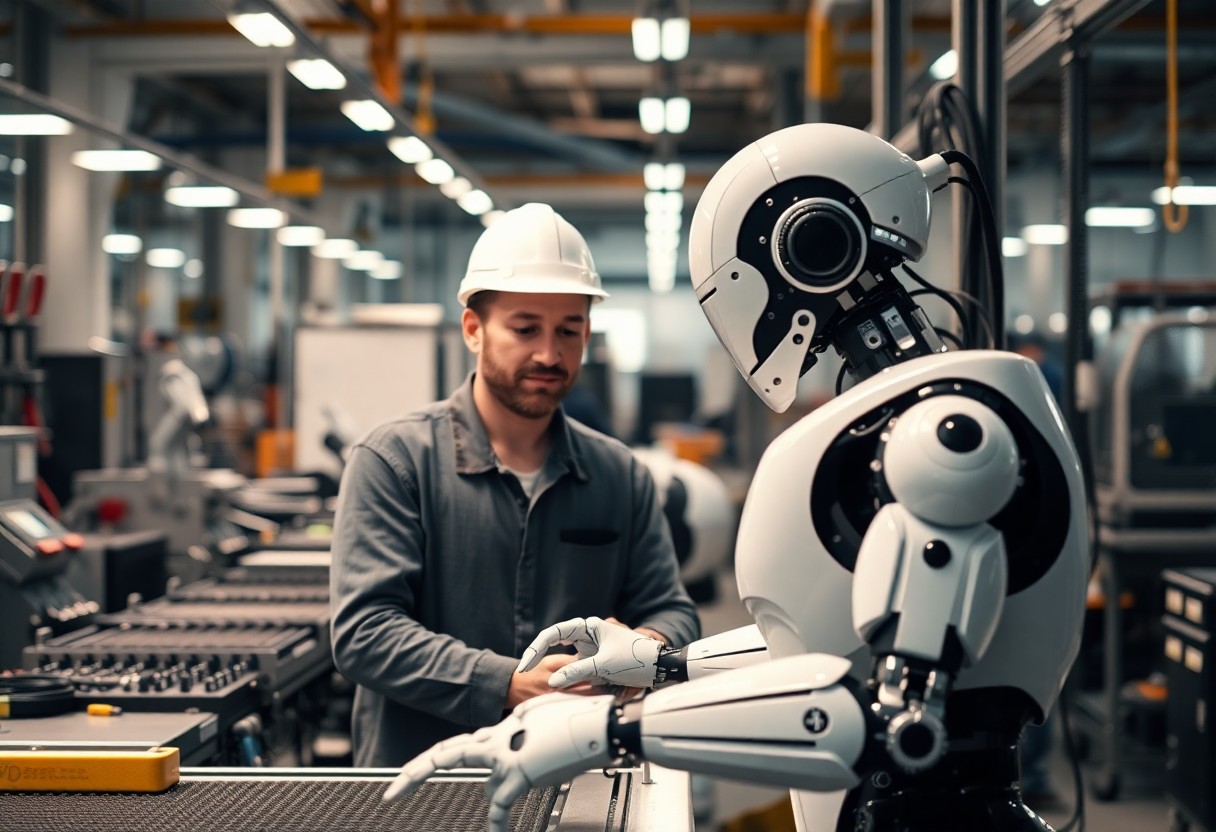Human-Robot Collaboration – Boosting Productivity Across Industries
Exploring Benefits Of Human-Robot Collaboration In The Workplace
March 25, 202510 Essential Kitchen Hacks For Healthier Meal Prep
March 26, 2025Robots have transformed the way you work, enhancing your productivity and efficiency across various industries. By integrating advanced robotics with human skills, you can leverage the unique strengths of both to tackle complex tasks and streamline processes. This collaboration minimizes work-related injuries by taking over hazardous duties, allowing you to focus on creative problem-solving. As you embrace this technology, you’ll find that human-robot partnerships not only enhance your productivity but also drive innovation and growth in your organization.
The Evolution of Human-Robot Collaboration
For decades, the landscape of human-robot collaboration has transformed dramatically, shifting from simple task automation towards intricate partnerships between humans and robots. This transition has redefined productivity and efficiency in various industries, allowing you to harness the best of both human intuition and robotic precision.
Historical Context
Evolution in human-robot collaboration traces back to early industrial robots introduced in manufacturing during the late 20th century. Initially, these machines operated independently, reducing human involvement. As needs evolved, your role shifted towards collaboration, fostering a closer symbiosis between humans and machines.
Key Technological Advances
Evolution in technology has revolutionized human-robot collaboration, driven by advancements in artificial intelligence, machine learning, and sensor technologies. These innovations empower robots to learn from their surroundings and adapt to your unique tasks seamlessly.
Consequently, the ability of robots to process complex data and interact with human workers has significantly improved. With enhanced sensors, robots can now operate alongside you, identifying and responding to your actions in real-time. Moreover, AI algorithms allow for better decision-making, granting robots the capacity to collaborate intelligently in dynamic environments. This evolution not only optimizes productivity but also enhances safety, enabling you to work alongside robots with increased trust and efficiency in your tasks.
Benefits of Human-Robot Collaboration
While the integration of robots into the workplace may seem intimidating, the benefits of human-robot collaboration are substantial. You can expect enhanced productivity, improved employee satisfaction, and the opportunity to tackle complex tasks more effectively. By leveraging the strengths of both human workers and robotic systems, your organization can achieve remarkable results that push the boundaries of innovation and efficiency across various industries.
Increased Efficiency
Across multiple sectors, human-robot collaboration leads to increased efficiency. By automating repetitive tasks, you can free up your employees to focus on higher-value work. This shift not only enhances overall productivity but also allows for a better allocation of resources, ensuring your team can achieve more in less time.
Improved Safety and Quality
Collaboration between humans and robots can significantly enhance workplace safety and product quality. The integration of robots can handle hazardous tasks that might expose your employees to risks, ensuring a safer work environment. Moreover, robots consistently perform tasks with precision, reducing the chances of human error and enhancing the overall quality of your products. This synergy creates a more secure workplace while enhancing your company’s reputation for reliability and excellence.
The advantages of improved safety and quality are profound; you can minimize workplace accidents and reduce downtime associated with injuries. By allowing robots to take on the most dangerous tasks, your employees can work in a more secure environment, leading to higher morale and productivity. More importantly, when robots deliver consistent quality, customer satisfaction increases, which is key to your long-term success and growth in the market.
Applications Across Different Industries
Some of the innovative how human robot collaboration will affect the manufacturing industry include enhancing operational efficiency, minimizing errors, and improving safety. This collaboration is transforming various sectors, enabling businesses to maximize productivity and reduce costs. From manufacturing to agriculture, robots are paving the way for more streamlined processes and improved results in the workplace.
Manufacturing
Along with workers, robots are enhancing productivity in the manufacturing sector by taking over repetitive tasks. This collaboration allows humans to focus on more complex decision-making aspects of production, driving efficiency and innovation.
Healthcare
Among the sectors benefiting from human-robot collaboration, healthcare is seeing significant advancements. Robots assist in surgery, patient monitoring, and drug preparation, enhancing care while reducing the workload on health professionals.
To further improve patient outcomes, robots can perform precise surgeries with increased accuracy, ensuring less recovery time for patients. They can also handle monotonous tasks such as organizing medical supplies, enabling you to devote more time to patient care, leading to better health results.
Logistics
To optimize supply chain operations, robots are revolutionizing logistics by streamlining the movement of goods. With the ability to work alongside human staff, they enhance efficiency in shipping, sorting, and inventory management.
But while robots handle tasks like sorting and picking, human oversight is still vital to tackle unexpected issues in logistics. This partnership allows for increased speed and accuracy in fulfilling orders, ultimately leading to better service and customer satisfaction.
Agriculture
With robots entering the agricultural sector, you can now experience enhanced productivity through automated planting, harvesting, and monitoring of crops. This collaboration allows farmers to optimize resources and increase yield.
It is vital to note that precision farming through robotic technology not only boosts productivity but also reduces the environmental impact of agriculture. By minimizing the need for chemical inputs and maximizing crop efficiency, this innovation is paving the way for a healthier planet.
Challenges and Considerations
Keep in mind that while human-robot collaboration has the potential to enhance productivity, it also introduces various challenges. You need to consider the complexities of integrating robots into existing workflows, addressing the varied skill levels of your workforce, and overcoming resistance to change. Additionally, ensuring safety standards and maintaining a harmonious workplace culture are vital to maximizing the benefits of this technology.
Integration and Adaptation
At the core of successful human-robot collaboration lies effective integration and adaptation. You will need to assess your current systems and identify how robotic technology can fit in. Training staff to work alongside robots and adapting workflows to leverage their strengths is vital for seamless cooperation.
Workforce Implications
By embracing human-robot collaboration, your workforce will undergo significant changes. While some roles may be displaced, new positions will emerge, requiring upskilling and reskilling of employees. You must recognize that these implications can lead to a more skilled workforce in the long run, as individuals adapt to interacting with advanced technology.
Another important aspect to consider is that reskilling your workforce is not just beneficial for productivity but also promotes job satisfaction and security. In the face of automation, you can create an environment where humans and robots effectively complement each other’s skills, enhancing overall performance. Furthermore, this transition offers potential for increased job creation in fields related to robot maintenance and programming, showcasing that the relationship between humans and robots can be both positive and productive.

Future Trends in Human-Robot Collaboration
Your engagement in human-robot collaboration will redefine productivity across various sectors. As technology advances, you’ll witness robots seamlessly integrating into the workforce, optimizing operations, and enhancing safety measures. This shift will not only transform traditional job roles but also usher in innovative ways to harness the unique strengths of both humans and robots for increased efficiency.
Advances in AI and Robotics
To enhance productivity, artificial intelligence and robotics are evolving rapidly, leading to smarter robots capable of understanding complex tasks. As these technologies improve, you’ll find robots that can analyze data, adapt to changing environments, and interact more intuitively with human teammates, ultimately making your collaboration more effective.
The Emergence of Collaborative Robots (Cobots)
Among the most notable advancements are collaborative robots, or cobots, designed to work alongside humans. These machines prioritize safety and ease of use, making them ideal for a wide range of applications in manufacturing, healthcare, and logistics.
Future implementations of collaborative robots (cobots) will continue to emphasize human safety and efficiency. Cobots are engineered to work alongside human workers, allowing for enhanced collaboration without the need for safety cages or extensive training. Their versatility means they can adapt to various tasks, from assembly line operations to assisting in surgeries, making them invaluable assets in sectors. With ongoing advancements, you can expect greater ease of use and affordability, ensuring that integration into your workflow is seamless. This transformative technology presents a positive outlook on the future of work, where humans and robots coexist harmoniously.
Case Studies of Successful Implementations
To illustrate the impact of human-robot collaboration, consider these notable case studies:
- BMW: Increased production efficiency by 30% through collaborative robots in assembly lines.
- Amazon: Integrated over 200,000 robots in warehouses, enhancing order fulfillment speed by 300%.
- Foxconn: Utilized collaborative robots to reduce assembly time by 50% in electronics manufacturing.
- Siemens: Implemented cobots that improved workplace safety and reduced human error by 80%.
Industry Leaders
Below, you can find how industry leaders are successfully leveraging collaborative robots to enhance productivity and streamline operations.
Real-World Examples
Below, you will discover how various organizations have effectively implemented human-robot collaboration to transform their operations.
Consequently, leading companies are proving that partnering with robots significantly boosts efficiency and enhances safety. For instance, during their expansion, a leading automotive manufacturer utilized collaborative robots which resulted in a reduction of workplace accidents by 60%. Warehouse automation has also demonstrated remarkable improvements, with businesses cutting labor costs and increasing shipping accuracy by up to 99%. As you can see, these real-world applications underscore the immense potential of human-robot collaboration across various sectors.
Conclusion
Considering all points, human-robot collaboration presents an incredible opportunity for you to enhance productivity across various industries. By seamlessly integrating robotic assistance into your workflows, you can improve efficiency, reduce operational costs, and increase accuracy in tasks. Embracing this technology not only empowers your workforce but also positions your organization at the forefront of innovation. As you look to the future, leveraging human-robot partnerships will be key to driving growth and remaining competitive in a fast-evolving market.
NEWSLETTER






